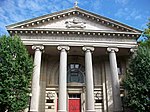Carnegie International
The Carnegie International is the oldest North American exhibition of contemporary art from around the globe. It was first organized at the behest of industrialist and philanthropist Andrew Carnegie on November 5, 1896 in Pittsburgh. Carnegie established the International to educate and inspire the public as well as to promote international cooperation and understanding. He intended the International to provide a periodic sample of contemporary art from which Pittsburgh's Carnegie Museum of Art could enrich its permanent collection. The work of thousands of artists has been exhibited in the Carnegie International, including that of Winslow Homer, Salvador Dalí, James Abbott McNeill Whistler, Mary Cassatt, Camille Pissarro, Auguste Rodin, Hermenegildo Anglada Camarasa, Willem de Kooning, Henry Moore, Jackson Pollock, René Magritte, Joan Miró, Alberto Giacometti, Andy Warhol, Joseph Beuys, Sigmar Polke, and William Kentridge.
Excerpt from the Wikipedia article Carnegie International (License: CC BY-SA 3.0, Authors).Carnegie International
South Craig Street, Pittsburgh
Geographical coordinates (GPS) Address Website Nearby Places Show on map
Geographical coordinates (GPS)
| Latitude | Longitude |
|---|---|
| N 40.44353 ° | E -79.94954 ° |
Address
Carnegie Museum of Art
South Craig Street
15213 Pittsburgh
Pennsylvania, United States
Open on Google Maps








